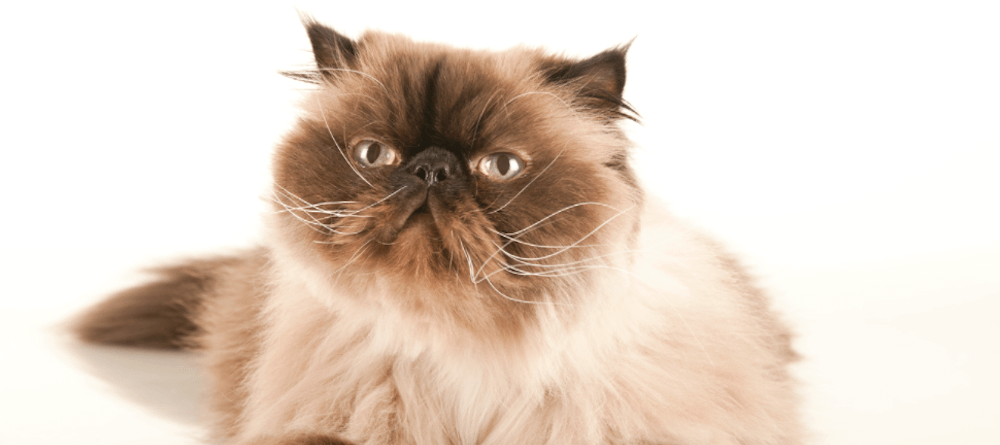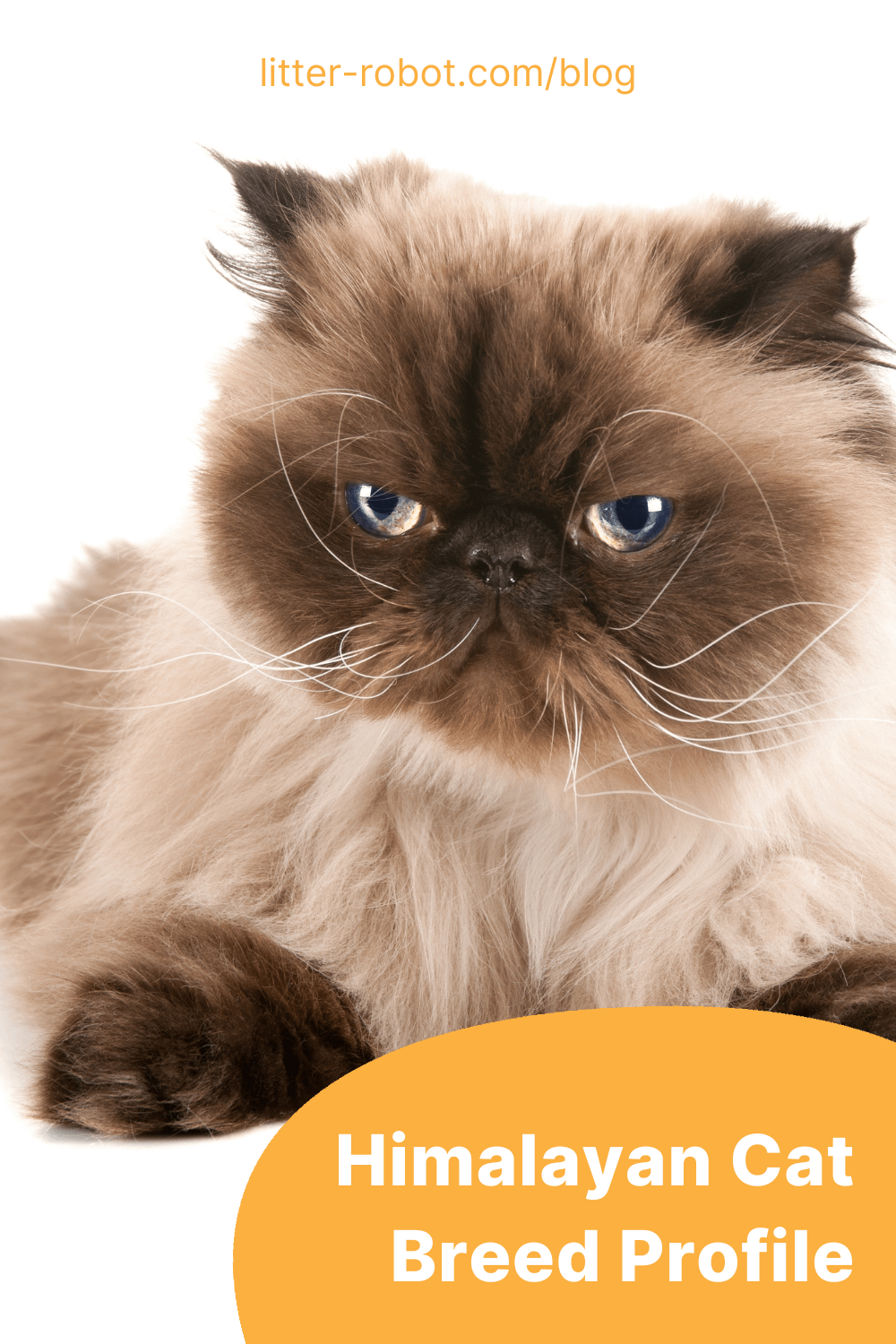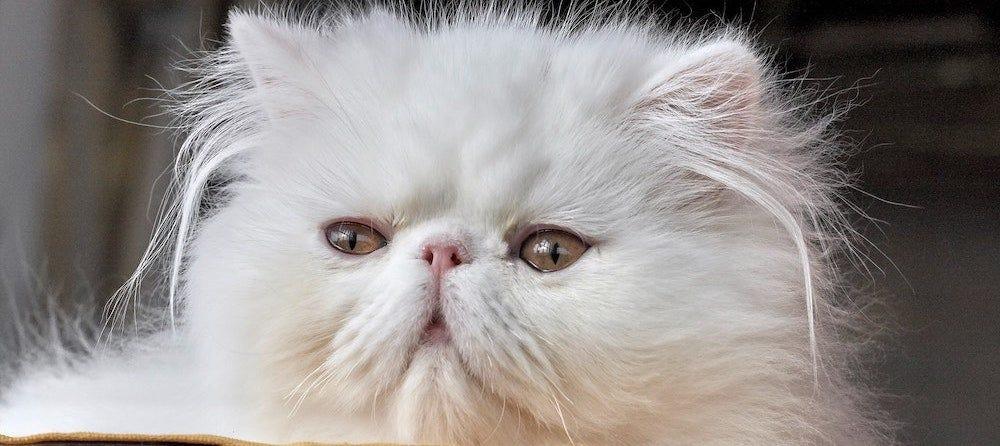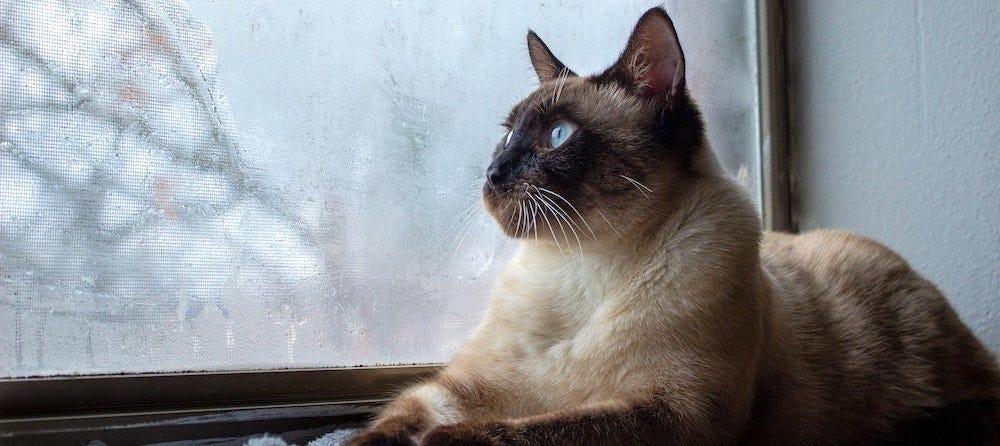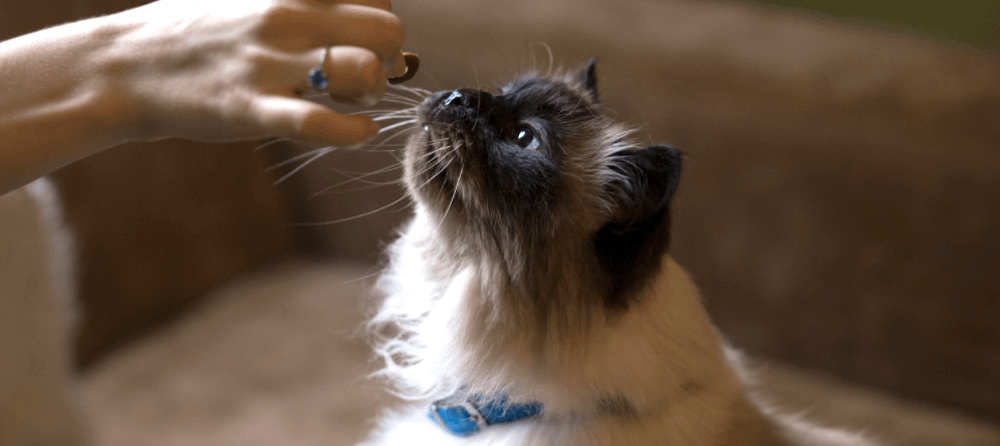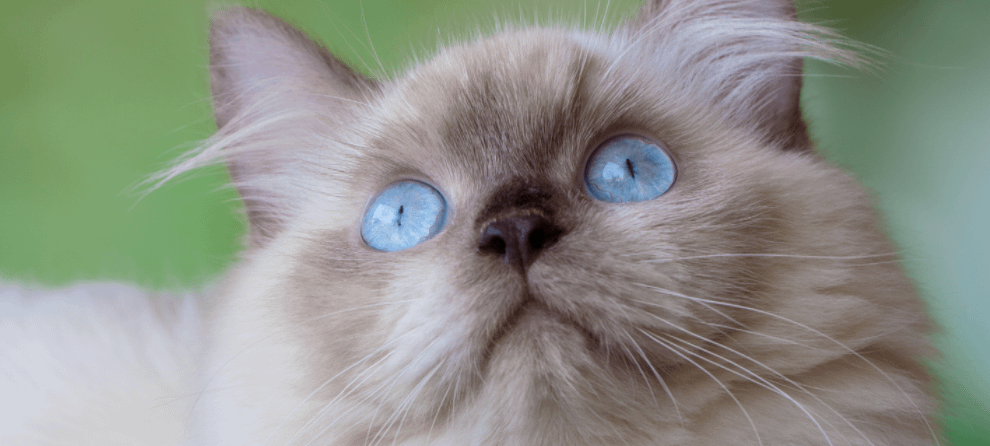Himalayan cats, or “Himmies” as they are often called, are hybrid cats crossed between Siamese and Persian breeds. What results from this crossover is the best of both worlds: long, silky fur from the Persian and pointed coloring with blue eyes from the Siamese. These cats are unique-looking and will draw you in with their lovable personalities.
The Himalayan is a muscular cat with strong bones that help keep them well-balanced. These cats give off a presence of power and dignity when they enter a room. Once you’ve earned the respect of these kitties, they will return it graciously.
| Himalayan cat | ...at a glance |
|---|---|
| Personality | Sweet, docile, quiet |
| Life expectancy | 10-15 years |
| Weight | 7-14 lbs |
| Coat & colors | Long, dense; colorpoint |
| Energy level | Low |
| Affection level | High |
| Friendliness | High |
| Shedding level | High |
| Required grooming | High |
Overview of a Himalayan cat

The Himalayan is considered a medium to a large-sized cat, and this has a lot to do with their heavy boning and long fur.
When you combine the two, you get a cat that looks a lot bigger than they might actually be. Himmies are already sturdy, but when you add the fur on top of their bodies, they instantly appear larger.
Weight
The typical weight range for a Himalayan cat is between 7 and 14 pounds, with males being a bit larger. Their fur gives them the illusion of weighing a lot more, especially with their broad chest and round abdomens.
Himalayan cats are known to have low energy levels, meaning that if their weight is not monitored, they could begin gaining rather than maintaining. Of course, they still like to play, but they really enjoy lounging. It will be up to you to initiate some playtime in order to get your Himmie moving.
Length
Himalayan cats can reach up to 19 inches in length, measuring from the end of the tail to their nose. Their tails are similar in length to their torso, and they have very round, slightly snubbed muzzles.
Coat
A Himalayan cat will have long, straight fur that includes a dense undercoat. Himalayans can be chocolate, lilac, red, tortoiseshell, cream, or many colors in between. The Himalayan will always have an obvious colorpoint pattern, like the Siamese cat.
In 2014, The Guinness Book of World Records deemed a Himalayan-Persian mix named Colonel Meow to have the longest hair.
Lifespan
Himalayan cats can live for 10 to 15 years when well cared for. If you are looking for a cat that will be by your side for years to come, the Himalayan can do that for you.
Loving a Himalayan cat is a special commitment. Just as you’ll change and grow over 15 years, so will your Himmie.
History of the Himalayan cat

In the early 20th century, cat breeders wanted to create a Persian cat that had colorpoint coat patterns like the Siamese. To create a new cat breed, the first deliberate crossing between a Siamese cat and a Persian cat occurred in the 1920s.
At Harvard in the 1930s, Clyde Keeler and Virginia Cobb worked together to create the first pointed longhair cat. First they crossed a female Siamese and a black Persian male to get black shorthair kittens. Then they bred a black Persian female and a Siamese male together and got the same result.
Because the colorpoint pattern and longhair genes are recessive, the breeders knew that both parents would need to have both genes. They decided to take a male from the first litter and a female from the second and mate them. What resulted was a cat with the coat pattern of a Siamese cat and the coat length of the Persian breed.
The International Cat Association (TICA) and the American Cat Fanciers Association (ACFA) recognize this breed as a separate entity. On the other hand, the Cat Fanciers Association (CFA) has ruled the Himalayan to be a Persian breed variety.
Despite any restrictions or rules from cat show organizations, lovers of Himmies are just happy to have their beautiful long-haired feline as a companion.
In the 1950s, the Himalayan was recognized and named for sharing a similar coloring as other animals, such as the Himalayan rabbit. In Britain, Himalayans have always been referred to as Colorpoint Longhairs, and recently, some registries in the United States call them Himalayan-Persians or Persian-Himalayans.
Despite the naming convention of some registries, Persian-Himalayans (and other misrepresented variants like Siamese-Himalayans) are simply Himalayans with traditional parent breeds.
Characteristics
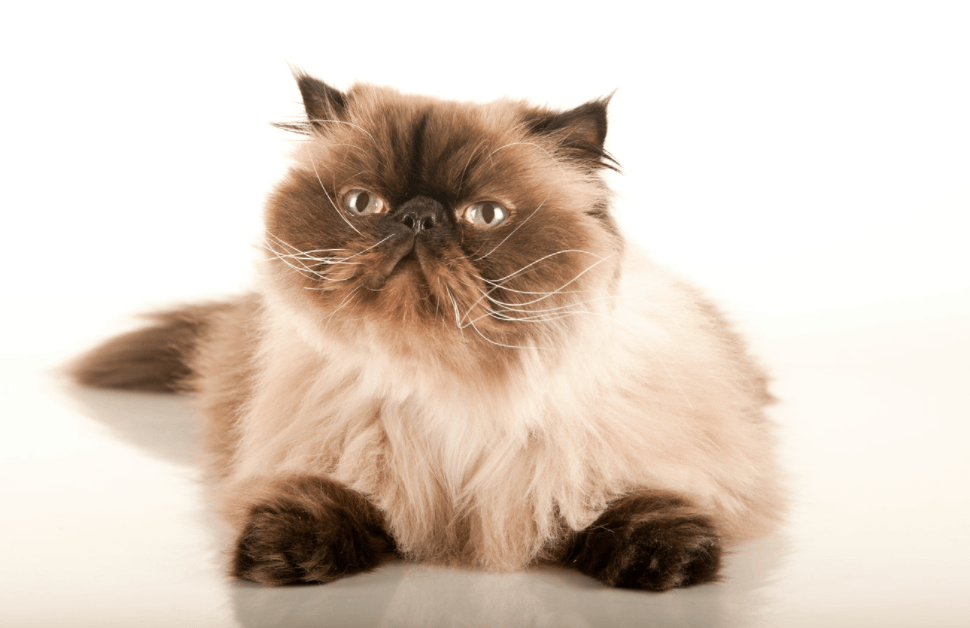
When you see a Himalayan, you recognize how round they look. They have round faces and bodies, with a deep-set chest and broad shoulders. They are muscular and well-developed, with large heads. Their ears are typically small and set wide apart. A Himalayan’s large, round eyes are striking, inquisitive, and watchful.
The doll-face Himalayan, also called “peke-faced” or brachycephalic, has developed a squished face through breeding program efforts. While this look is adored by many, it can pose health problems.
The Himalayan’s fur gives them a larger appearance. Even though they are smaller than they look, they are still sturdy and strong cats. If your Himalayan is healthy, you will be able to feel their defined muscles.
Personality
Himalayan cats are the epitome of a relaxed and gentle pet. Their size does not deter them from being incredibly affectionate and easygoing. They have a fondness for attention and interactive playtime, preferring to engage with their humans rather than entertaining themselves.
A Himalayan cat thrives on companionship and can become discontent if they feel neglected. Their devotion to their family is unwavering, and they easily form strong bonds with each member. They have an inherent need for affection and will seek it from those they trust the most.
These cats are highly adaptable and accepting, making them comfortable around new people. Himalayans are not just docile and easygoing, they also enjoy a stimulating challenge. After an engaging play session, they are content to curl up next to you for a well-deserved catnap.
Caring for a Himalayan
Be ready for a commitment: Grooming your Himalayan is critical, and it might be a little time-consuming.
Their hair is very fine and silky, which leads to matting and tangling. Using a wide-toothed comb for daily brushing will keep your Himmie silky and soft as well as clean. This helps to remove dirt and dust that can collect in their fur.
If you aren’t willing to take your Himalayan to a professional groomer every few months, you might not be ready for one. They require top-tier care in order to be comfortable and happy. Luckily for you, Himalayans truly love being groomed by their family members because it means they get love and affection from them!
Keeping your Himalayan’s litter box tidy is also essential. They have long fur and want to keep themselves as clean as possible. If the litter box is full, they risk dirtying their fur and paws.
Litter-Robot makes cleaning up after your cat a breeze. This self-cleaning litter box gives kitty a fresh bed of litter to do their duty and walk away with cleaner paws.
Possible health issues
Not every Himalayan will have health problems, but it’s important to learn about potential risks associated with the breed. Keeping an eye on your pet and taking them to the veterinarian regularly can help to ensure they stay healthy and happy.
Himalayans have flat faces, leading to the risk of respiratory issues and excessive tear production. They are also susceptible to Polycystic Kidney Disease (PKD), which occurs when cysts form on the kidneys and can cause bacterial infections over time. If caught early, this can be treatable.
Additionally, Himalayans are at risk of obesity due to their low energy levels and preference for lounging. This makes regular exercise and weight monitoring essential for this breed. Dental issues can also be prevalent due to their brachycephalic nature, requiring regular dental care. The breed's long coat can also lead to hairballs, so daily grooming is a necessity.
Loving a Himalayan cat
This cat is a bonafide star, appearing in the beloved movies "Homeward Bound" and "Meet the Parents," as well as being the favored pet of Martha Stewart.
A Himalayan cat will show you love and loyalty in return for your own. These cats are sweet and want to spend their time with their families.
On average, you can expect to pay anywhere from $500 to $2000+ for a Himalayan kitten from a reputable breeder. Adoption from shelters or rescue organizations is another option if you want to take home a Himalayan cat at a lower cost while also providing a loving family to a cat in need.
Taking care of any pet can be intimidating, but these mellow felines work with you to help you learn and grow. What comes after that bond is formed is absolutely priceless!
Sources:
